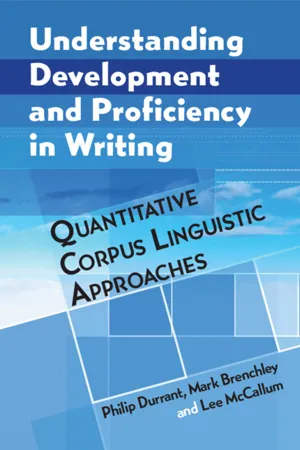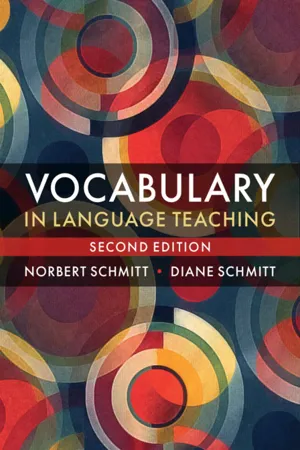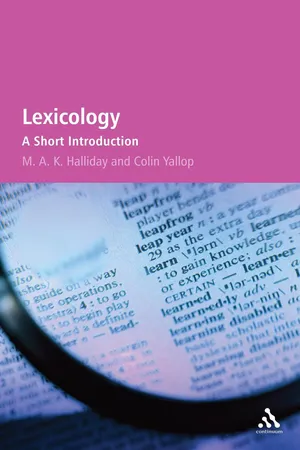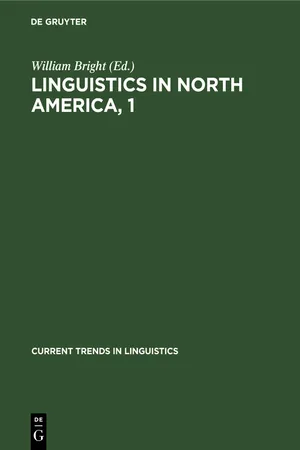Languages & Linguistics
English Vocabulary
English vocabulary refers to the collection of words and phrases used in the English language. It encompasses a wide range of words, from common everyday terms to specialized jargon. Building a strong English vocabulary is essential for effective communication, reading comprehension, and language proficiency.
Written by Perlego with AI-assistance
Related key terms
1 of 5
6 Key excerpts on "English Vocabulary"
- eBook - PDF
Understanding Development and Proficiency in Writing
Quantitative Corpus Linguistic Approaches
- Philip Durrant, Mark Brenchley, Lee McCallum(Authors)
- 2021(Publication Date)
- Cambridge University Press(Publisher)
4 Development in Vocabulary 4.1 Introduction Vocabulary has been a popular focus for quantitative studies of language development, with the last ten years seeing a greatly increased number of studies (as shown in Chapter 1). There are two likely reasons for this. First, vocabulary is perceived to be central to both language learning and education more broadly. It is a popular conception among students and educators that learning a language is largely a matter of learning words and that difficulties with language can be attributed to a lack of vocabulary. Several studies have shown that both first- and second-language users of English cite inadequate vocabulary knowledge as a key barrier to their success on university courses (Berman & Cheng, 2010; Evans & Green, 2007; Evans & Morrison, 2011; Fung, 2006). Research has demonstrated that this conception has some truth to it. As the review below will show, writing development is (often very strongly) linked to changes in vocabulary use. Moreover, studies have shown that vocabulary use is a predictor of academic success for both L1 and L2 speakers in a number of different areas (Daller & Phelan, 2013; Douglas, 2010; Morris & Cobb, 2004; Pennebaker, Chung, Frazee, Lavergne, & Beaver, 2014). Second, among all of the linguistic measures that are discussed in this book, vocabulary appears, prima facie, to be the best-suited to large-scale computa- tional analysis. If words are simply defined as stretches of letters surrounded by white space or punctuation marks, the words in a text can easily be enumerated, their distributions analysed, and comparisons made against reference corpora or listings of words rated for various properties. This has given researchers a relatively user-friendly way into work with vocabulary. However, this apparent simplicity disguises a number of thorny issues. - eBook - PDF
Researching Vocabulary
A Vocabulary Research Manual
- N. Schmitt(Author)
- 2010(Publication Date)
- Palgrave Macmillan(Publisher)
1 1.1 Ten key issues 1.1.1 Vocabulary is an important component of language use Quote 1.1 Wilkins on the importance of vocabulary for communication Without grammar very little can be conveyed, without vocabulary nothing can be conveyed. (1972: 111) 4 Overview of Vocabular y Issues One thing that all of the partners involved in the learning process (stu- dents, teachers, materials writers, and researchers) can agree upon is that learning vocabulary is an essential part of mastering a second language. The importance of vocabulary is highlighted by the oft-repeated obser- vation that learners carry around dictionaries and not grammar books. However, it is important to provide empirical evidence to back up this type of anecdotal observation (after all, this is a research manual!). This is easily done, as there is plenty of evidence pointing to the importance of vocabu- lary in language use. One strand of this evidence is the typically high correlations between vocabulary (usually measures of vocabulary size) and various measures of language proficiency. For example, a close relationship has been shown between vocabulary size and reading (e.g. correlations of .50–.75, Laufer, 1992). 2 Furthermore, Laufer and Goldstein (2004) found that knowing the form-meaning link of words accounted for 42.6% of the total variance in participants’ class grades according to a regression analysis. Given that the language class grade reflected performance on reading, listening, speaking and writing, grammatical accuracy, sociolinguistic appropriateness, and language f luency, the above figure indicates that vocabulary knowledge contributes a very great deal to overall language success. Albrechtsen, Haastrup, and Henriksen (2008) compared measures of vocabulary size and depth (association tests) of Danish ESL learners with several measures of the ability to use English. - eBook - PDF
- Norbert Schmitt, Diane Schmitt(Authors)
- 2020(Publication Date)
- Cambridge University Press(Publisher)
. . . . . . . . . . . . . . . . . . . . . . . . . . . . . . . . . . . . . . . . . . . . . . . . . . . . . . . . . . . . . . . . . . . . . . . . . . . . . . . . . . 1 The Nature and Size of Vocabulary • Are there any patterns among the many thousands of words in a language? • How should we count vocabulary? • How much vocabulary do L1 English speakers know? Second language learners? • How much vocabulary does it take to operate in English? The White Rabbit put on his spectacles. “Where shall I begin, please your Majesty?” he asked. “Begin at the beginning,” the King said, very gravely, “and go on till you come to the end: then stop.” Lewis Carroll, Alice’s Adventures in Wonderland, p. 106 The advice given in the above quote from Alice in Wonderland seems to be appro- priate for an introductory text, so to start at the beginning we must consider what we mean by vocabulary. The first idea which probably springs to mind is words. Every language is made up of words, and they come in an amazing variety. Some are short (a), some are long (antidisestablishmentarianism), some seem old (anon), and some have just entered the language (bling: expensive, ostentatious clothing or jewelry). Some have a single, straightforward meaning (quarantine), some carry several differ- ent meanings (bank: financial institution, riverside, a row of things, turning an airplane), and some convey a load of positive/negative connotations (aroma/stench). Some are common (sky, eat) and some are hardly ever used (punctilious). This chapter will discuss the nature of vocabulary, and will show that there are useful patterns in the sea of words. If the patterns are understood, it can make teaching and learning vocabulary much more systematic and successful. The chap- ter will also discuss how much vocabulary there is in language (vocabulary size), and how much must be known in order to be functional in English. - eBook - PDF
Lexicology
A Short Introduction
- M.A.K. Halliday, Colin Yallop(Authors)
- 2007(Publication Date)
- Continuum(Publisher)
And in unwritten languages the 'word' can be a very elusive thing. Nevertheless there is a general concept underlying all this diversity; that is the lexical item. Every language has a vocabulary, or 'lexicon', which forms one part of its grammar — or, to use a more accurate term, one part of its lexicogrammar. The lexicogrammar of a language con-sists of a vast network of choices, through which the language construes its meanings: like the choices, in English, between 'positive' and 'negative', or 'singular' and 'plural', or 'past', 'present' and 'future'; or between 'always', 'sometimes' and 'never', or 'on top of and 'underneath'; or between 'hot' and 'cold', or 'rain', 'snow' and 'hail', or 'walk' and 'run'. Some of these choices are very general, applying to almost everything we say: we always have to choose between positive and negative whenever we make a proposition or a proposal (it's raining, it isn't raining] run! don't run!). Others are very specific, belonging to just one domain of meaning; these arise only when we are concerned with that particular domain. The choice between rain and snow, for example, arises only if we are talking about the weather. Choices of this second kind are expressed as lexical items: e.g. hot/ cold; rain/snow/hail] walk/run. 3 Lexicology: A Short Introduction If we are using the term 'word' to mean a unit of the written language, i.e. 'that which (in English) is written between two spaces', then ultimately all these choices are expressed as strings of words, or wordings, as in it always snows on top of the mountain. But teachers of English have customarily distinguished between content words, like snow and mountain, and function words, like it and on and o/and the] and it is the notion of a content word that corresponds to our lexical item. Lexicology is the study of content words, or lexical items. - eBook - PDF
- William Bright(Author)
- 2019(Publication Date)
- De Gruyter Mouton(Publisher)
APPROACHES TO LEXICOGRAPHY A N D SEMANTICS ALLEN WALKER READ From the point of view of linguistics as a science, lexicography is a very 'impure' field. It cuts across many areas of investigation and can best be pursued by a polymath or at least a 'generalist'. Its methods have been largely determined by what a non-scientific readership expects of it, and it is deeply encrusted by tradition. As commonly accepted, its task is to provide an inventory of the words of a language, together with relevant information about the words. 1. INVENTORYING THE LEXICON OF ENGLISH The chief inventory of the English word stock, the Oxford English dictionary (OED), edited from 1882 to 1928, with a Supplement s 1933, is a monument of the scholarship of England, but North American scholars have taken part in supplementing it. Years before the OED was finished, as printing costs soared even in those times, it was realized that the work could never be revised and re-set. Therefore on April 4th, 1919, Dr. W. A. (later Sir William) Craigie presented a plan before the Philological Society in London for a set of works that came to be known as 'period dictionaries'. As he said: 'Yet each definite period of the language has its own characteristics, which can only be appreciated when it is studied by itself, and which are necessarily obscured when it merely comes in as one link in the long chain of the language as a whole. To deal adequately with each period it is necessary to take it by itself and compile for it a special dictionary, as full and complete as may be.' 1 He gave consideration to six such areas, and in 1925 he made a report that added another. 2 Of these seven areas, American scholars have moved forward in four. The most outstanding project has been the Middle English dictionary, covering the period 1100 to 1475. - eBook - PDF
- Rob Penhallurick(Author)
- 2018(Publication Date)
- Bloomsbury Academic(Publisher)
These compara-tively short lists are dialect glossaries (such as the Exmoor Vocabulary by Devoniensis), and any student of dialect, with a bit of time, patience, and practice, can research and produce their own dialect glossary, thereby contrib-uting to the lexicographical tradition in dialect study, lexicography being the making of dictionaries and glossaries. And there have been some great dialect dictionaries – great in the sense of LARGE , quite a few of them MONUMENTAL, as well as great in terms of their achievement. A glance at any of the bigger dictionaries, such as the 4700-page English Dialect Dictionary (1898–1905, edited by Joseph Wright), might provoke the fleeting thought that one would have to be a little mazed to take on such a task, in which case there have been a good number of mazed dialect lexicographers. In dialect lexicography, then, the term dictionary usually refers to the larger projects, and glossary usually to the smaller in scale. The investigation of vocabulary is a tradition in the study of dialects of English which can be traced back to the sixteenth century. This chapter and the next will tell the story of this tradition. We will negotiate the rich mass of surveys by looking at the main contributions, their motivations, methods, assumptions, and their achievements. The term dialect itself is defined briefly in the Preface, yet a key theme of Chapters 1 and 2 is the very process by means of which the dialectal or regional became identified in the English language. We will be concerned with dictionaries and glossaries of regional dialect rather than with the treatment of dialectal items in other types of dictionary, although that issue is of some 3 Lexicography: From early works to The English Dialect Dictionary relevance here. Neither will we deal with the lexicography of slang, nor of occu-pational dialect and jargon, although the borders between these and regional dialect are sometimes quite blurry.
Index pages curate the most relevant extracts from our library of academic textbooks. They’ve been created using an in-house natural language model (NLM), each adding context and meaning to key research topics.





